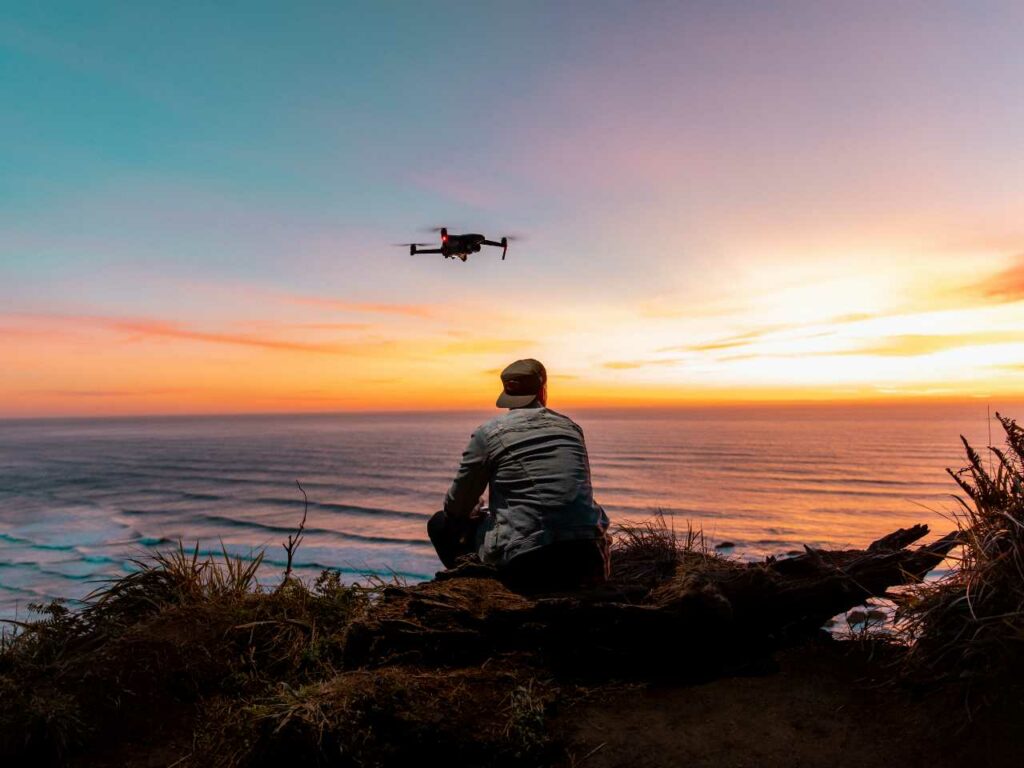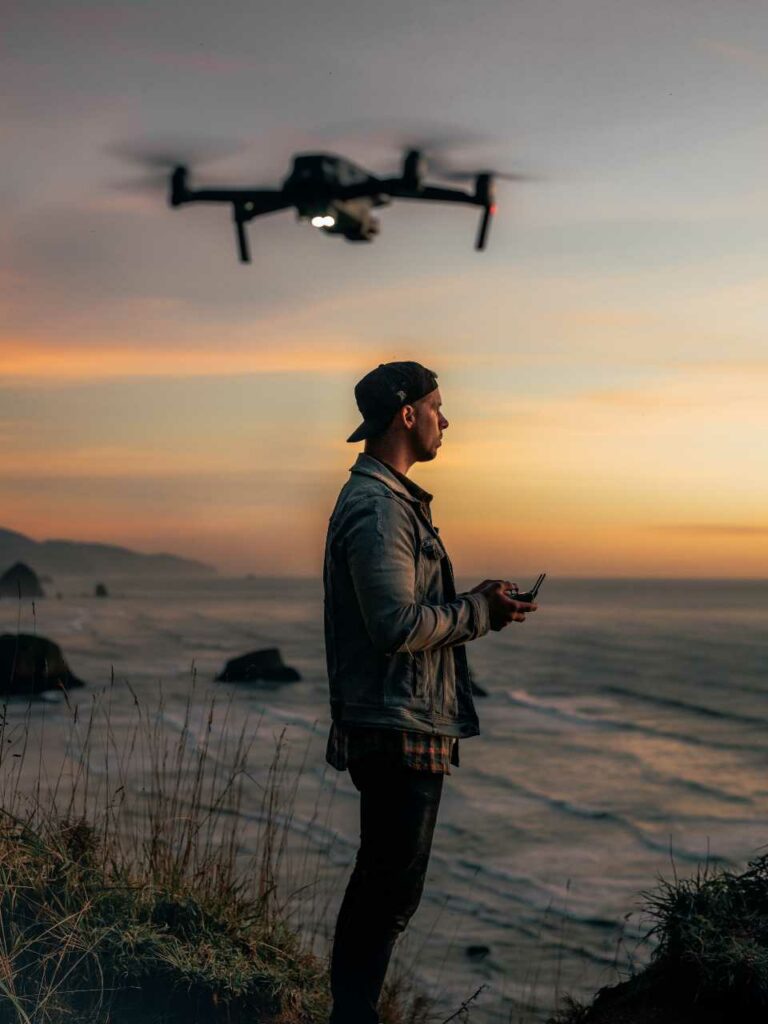Commercial video production has witnessed a revolutionary transformation with the emergence of drone videography. Once a niche luxury, drone footage is now a pivotal aspect of dynamic visual storytelling, offering a fresh perspective that ground-based cameras can’t match. Drone videography not only enhances the aesthetic appeal of commercial videos but also provides a unique viewpoint, which is crucial for businesses and agencies aiming to stand out. As this technology becomes increasingly accessible, understanding the nuances of drone certification and international licensing is becoming more critical, especially for projects like Spotted Fox Digital Marketing’s recent venture in the Netherlands. Let’s dive in!
Advantages of Drone Videography in Storytelling

Drone videography is not just about capturing footage from a bird’s eye view; it’s a powerful storytelling tool transforming commercial video production. The advantages of using drones in videography extend far beyond just a novel angle or perspective. They offer an opportunity to create lasting visual impressions, add depth and dimension to storytelling, and distinguish a brand in a saturated market. Let’s delve into how these three core benefits of drone videography can elevate the impact and effectiveness of commercial video content.
#1: Captivating Visuals with Drone Shots
In the competitive landscape of commercial video production, the impact of drone videography cannot be understated. Aerial footage offers breathtaking visuals, providing sweeping views that capture the magnificence and distinctiveness of a location, event, or property. This kind of immersive imagery does more than just showcase a scene; it leaves a powerful impression on potential customers. By presenting a visually compelling story from the skies, drone videography evokes strong emotions and a sense of connection. This enhances brand recognition and significantly boosts recall, making it an invaluable tool in the arsenal of modern marketing.
#2: Cost-Effective Aerial Perspectives
Beyond its narrative power, drone videography also stands out for its cost-effectiveness, especially when compared to traditional aerial filming methods. Traditional aerial shoots typically require helicopters or manned aircraft, which not only incur higher rental and fuel costs but also come with a set of logistical complexities and limitations. In contrast, drones offer a more economical solution without compromising on the quality of the footage. They can be deployed quickly and easily maneuvered, significantly reducing the time and expense involved in capturing stunning aerial shots. This affordability allows even smaller businesses and projects to access high-quality aerial footage, leveling the playing field in commercial video production.
#3: Differentiating with Aerial Innovation
Utilizing drone videography places businesses a cut above the rest in today’s market. It’s a clear sign of embracing innovation and cutting-edge technology, distinguishing your brand amidst a sea of conventional advertising. In an environment where consumers are bombarded with traditional marketing, drone and aerial footage offer a novel, engaging way to capture and retain audience attention. This unique approach enhances brand visibility and fosters greater customer engagement. Consequently, integrating drone videography into commercial video production can lead to increased audience interest and higher conversion rates, solidifying a brand’s presence in the competitive marketplace.
Navigating Global Drone Regulations
The rapidly evolving landscape of drone videography in commercial video production demands an understanding of international drone licensing. Drones, or Unmanned Aerial Vehicles (UAVs), are subject to varied and continually developing regulations worldwide. Keeping abreast of these changes is crucial for professionals in drone videography, especially when working on international projects. The complexity of drone laws and their swift evolution underscores the importance of staying informed to ensure legal compliance and successful project execution.
Key Regulatory Considerations Worldwide
Globally, drone regulations primarily focus on several core areas, regardless of the country:
- Insurance coverage: Requirements for liability insurance to cover potential damages caused by drones.
- Aircraft registration: Necessity to register drones with aviation authorities, often based on weight or usage.
- Drone and pilot licensing: Different licenses might be required for commercial versus recreational use, and these can vary widely between countries.
- Restricted zones: Areas where drone operation is limited or prohibited, such as near airports or national parks.
Comparative Overview of Drone Laws
Each country has its own regulations for drone use. Here’s a fundamental overview by continent:
- European Union (including Iceland, Lichtenstein, Norway, and partially Switzerland and the United Kingdom):
- Registration is required for drones over 250 grams.
- The registration number must be displayed on the drone. Laws distinguish between commercial and personal use.
- The European Commission’s regulations focus on the drone’s weight, safety requirements, and operation nature.
- North America:
- Most countries, like the USA and the Bahamas, require paperwork but don’t restrict much.
- 5 countries, including Canada and Jamaica, have few restrictions, mainly near airports, with registration required.
- 3 countries, including Cuba, Belize, and Nicaragua, have very strict regulations.
- Drones are prohibited in Barbados, Cuba, and the Bahamas.
- Mexico requires the Directorate General of Civil Aeronautics to set guidelines, including no BVLOS flights, height limits, and area restrictions.
- Most countries, like the USA and the Bahamas, require paperwork but don’t restrict much.
- South & Central America:
- Welcoming to drones in all countries, with varying permit requirements.
- Countries like Brazil, Colombia, and Peru require permits or registration.
- For smaller drones, Argentina, Bolivia, and Chile are more relaxed.
- Welcoming to drones in all countries, with varying permit requirements.
- Asia & India:
- Diverse regulations across countries. Here are some examples:
- India allows only Indian citizens to pilot drones, with classification based on weight and specific operational rules.
- Southeast Asia: Generally welcoming, but regulations vary. For example, Brunei bans drones, whereas Cambodia has minimal rules.
- Indonesia and the Philippines have specific guidelines and penalties.
- In Japan, drone deliveries and personal use are legal.
- Singapore offers commercial drone delivery services.
- Diverse regulations across countries. Here are some examples:
- Africa:
- Wide variance in drone regulations.
- Countries like Egypt, Libya, and Morocco are very restrictive; South Africa, Mozambique, and Cape Verde are less so.
- Wide variance in drone regulations.
- Oceania:
- Australia and New Zealand have specific drone regulations focusing on safety, area, and altitude restrictions.
Understanding these variations in drone laws is critical for ensuring compliance in international videography projects. Differences in the approach to UAV regulation, such as weight thresholds for registration or specific licensing requirements, highlight the need for thorough research and compliance when planning drone shoots in different countries. Of course, it is vital to always check local regulations – such as county and city laws as well!
Steps to Obtain FAA Part 107 License for Drone Certification
Embarking on a career as a commercial drone pilot requires obtaining an FAA Part 107 License drone certification. This section breaks down the process into manageable steps, but we want to emphasize that reviewing the FAA’s official website for the most current information is critical.
Understanding the Importance of Drone Certification
Gaining a Part 107 license is more than just a regulatory hurdle; it opens a realm of professional opportunities in various fields such as mapping, photography, search and rescue, and much more. The drone service industry is burgeoning, with Precedence Research estimating that by 2031, the projected value will be $68.62 billion. This drone certification signifies your comprehension of critical operational and safety norms necessary for safe and legal drone operation.
Step-by-Step Guide to Earning Your Drone Certification
Eligibility and Preparation:
To be eligible, you must be at least 16 years old, fluent in English, and in good physical and mental condition to fly a drone safely. Preparation for the aeronautical knowledge exam is critical, covering areas such as regulations, airspace classifications, weather impacts, loading, emergency procedures, and more. For a thorough understanding and successful passing of the Part 107 exam, using the FAA’s official study guide is advisable. Numerous online resources, including Drone U, offer comprehensive guides, practice exams, and instructional materials to aid your preparation.
Taking the Part 107 Exam:
The test comprises multiple-choice questions assessing your knowledge in the aforementioned areas. Passing this exam is crucial for proceeding with your application.
Application Process:
After passing the exam, one must complete the FAA Form 8710-13 through the Integrated Airman Certification and Rating Application (IACRA) system. For existing Part 61 certificate holders, additional steps like completing an online training course and providing evidence of a recent flight review are required.
Certificate Issuance:
Post submission, you’ll undergo a TSA security background check. On clearance, you’ll receive an email with instructions to print a temporary certificate from IACRA. The permanent certificate arrives by mail within 6-10 weeks.
In summary, obtaining your Part 107 license requires diligent preparation, understanding of necessary regulations, and successful completion of the FAA exam. The drone certification ensures compliance with aviation laws and significantly enhances your professional prospects in the dynamic field of drone piloting.
Spotted Fox’s International Drone Videography Success

Earlier this year, Spotted Fox Digital Marketing embarked on an exciting international video project showcasing our creative prowess and the importance of proper certification in drone operations. The project involved our trip to the Netherlands, led by our video production manager Evan, to film for Verbruggen Palletizing Solutions. This venture was a unique challenge, requiring Evan to obtain an international drone license before traveling to Europe. The breathtaking aerial footage captured for the project dramatically enhanced the final video, which can be viewed HERE.
Spotted Fox Digital Marketing highly emphasizes certifications like international drone certification for several reasons. First and foremost, it ensures legal compliance with international aviation and drone laws, which vary significantly from one country to another. Adhering to these regulations protects us from legal issues and upholds our reputation as a responsible and ethical company. Additionally, having these drone certifications opens doors to unique filming opportunities worldwide. It shows our commitment to maintaining the highest standards in our projects, regardless of the location, giving clients confidence in our capabilities and dedication to quality and legal compliance.

The addition of drone videography brought an unparalleled edge to the Verbruggen project. The drone footage provided a dynamic, expansive perspective that ground-level filming simply could not achieve. This bird’s-eye view offered a comprehensive visualization of Verbruggen’s operations, adding both aesthetic beauty and a strategic overview of the facilities and processes. This visual appeal, coupled with strategic storytelling, enhanced the viewer’s experience and significantly contributed to the effective communication of Verbruggen’s brand and capabilities. Drone footage, in essence, turned a standard corporate video into an engaging, memorable narrative, demonstrating the powerful impact of integrating cutting-edge technology with creative vision.
The Future of Drone Videography
Drone videography is revolutionizing the realm of commercial video production, opening up new horizons for creativity and innovation. Delving into the broader impact of this technology, let’s explore how drone videography is charting a new course for the future of commercial video production.
Drones have significantly altered the landscape of video production, offering an ability to capture stunning, high-quality aerial footage that was once only possible with expensive helicopter or crane shots. This advancement is democratizing film and video production, making breathtaking aerial shots accessible to more creators and businesses. The impact goes beyond just aesthetics; drones are now crucial for storytelling, providing unique angles and perspectives that enhance narrative and thematic elements.

Looking ahead, drone technology is poised to become even more innovative and integrated within the industry. Advancements in battery life, flight stability, and camera quality are ongoing, enabling longer and more intricate shots. Furthermore, integrating AI and machine learning can lead to more autonomous drones capable of executing complex filming techniques with minimal human intervention, making them even more valuable for filmmakers and marketers.
As regulations evolve and technology advances, we will likely see drones used in more creative and diverse ways. Their ability to capture not only expansive outdoor panoramas but also intricate indoor scenes could redefine the standards of storytelling in video production, impacting everything from commercials and documentaries to feature films and television. Drone videography isn’t just a fleeting trend; it’s a transformative tool reshaping how we capture and tell stories visually.
Elevate Your Story with Aerial Brilliance with Spotted Fox
Compelling visual content is key to capturing audience attention in today’s rapidly evolving digital landscape. At Spotted Fox Digital Marketing, we specialize in bringing unique perspectives and breathtaking aerial footage to your brand’s story, setting you apart in a crowded market. Elevate your brand’s visual storytelling with unparalleled drone videography. Reach out to Spotted Fox Digital Marketing to capture your vision from the skies!
